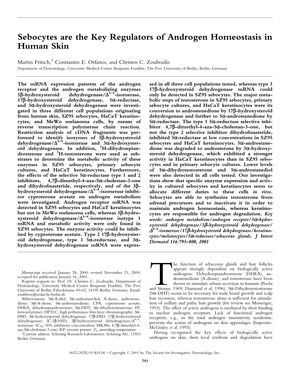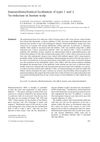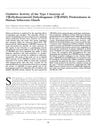Sebocytes are the Key Regulators of Androgen Homeostasis in Human Skin

TLDR Sebocytes play a key role in controlling androgen levels in human skin.
The study investigated the expression and activity of androgen receptor and androgen metabolizing enzymes in three human skin cell populations: SZ95 sebocytes, HaCaT keratinocytes, and MeWo melanoma cells. It was found that androgen receptor mRNA was present in SZ95 sebocytes and HaCaT keratinocytes but not in MeWo melanoma cells. SZ95 sebocytes were unique in expressing 3beta-hydroxysteroid dehydrogenase/Delta(5-4)-isomerase isotype 1 mRNA and its metabolic activity, which could be inhibited by cyproterone acetate. All three cell types expressed type 2 17beta-hydroxysteroid dehydrogenase, type 1 5alpha-reductase, and 3alpha-hydroxysteroid dehydrogenase mRNA, but only SZ95 sebocytes expressed type 3 17beta-hydroxysteroid dehydrogenase mRNA. Testosterone was primarily metabolized to androstenedione and then to 5alpha-androstanedione, with the type 1 5alpha-reductase inhibitor effectively inhibiting this process. 5alpha-androstanedione was further degraded to androsterone, with HaCaT keratinocytes showing stronger activity than SZ95 sebocytes. The study concluded that sebocytes and keratinocytes have distinct roles in androgen metabolism, with sebocytes synthesizing and inactivating testosterone to maintain homeostasis, while keratinocytes are more involved in androgen degradation.
View this study on jidonline.org →
Cited in this study

research Expression of mRNA for androgen receptor, 5alpha-reductase and 17beta-hydroxysteroid dehydrogenase in human dermal papilla cells

research Immunohistochemical localization of types 1 and 2 5α-reductase in human scalp
The study found that two enzymes linked to hair loss are located in different parts of the scalp, supporting a common treatment's effectiveness.

research Oxidative Activity of the Type 2 Isozyme of 17β-Hydroxysteroid Dehydrogenase (17β-HSD) Predominates in Human Sebaceous Glands
The enzyme 17β-HSD type 2 mainly performs oxidation in human sebaceous glands, which may help protect against acne.
research The Human Sebocyte Culture Model Provides New Insights into Development and Management of Seborrhoea and Acne
The human sebocyte culture model has improved understanding of oily skin and acne, and how they can be treated.

research Inhibition of rat α-reductases by finasteride: Evidence for isozyme differences in the mechanism of inhibition
Finasteride effectively blocks rat enzymes, but with varying methods and strength.
research Androgen metabolism in hirsute patients treated with cyproterone acetate
Cyproterone acetate effectively reduced hair growth in hirsute patients by lowering androgen levels and altering androgen metabolism.